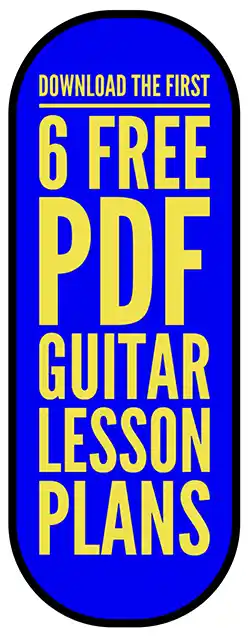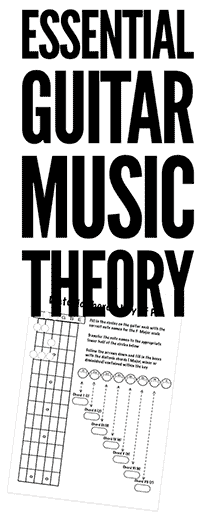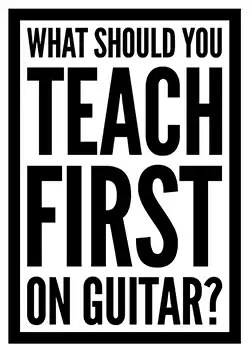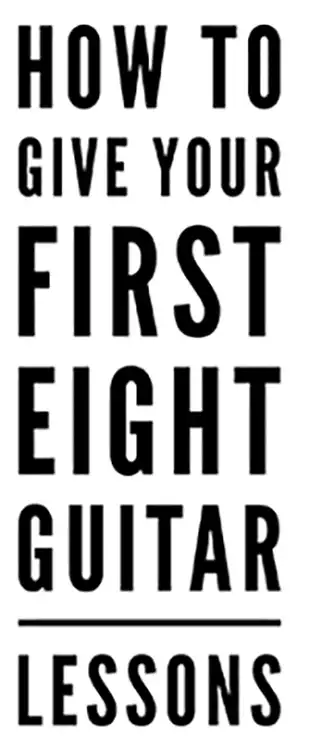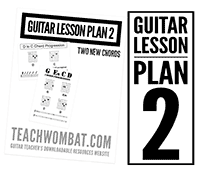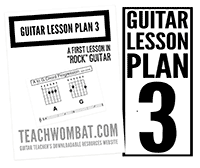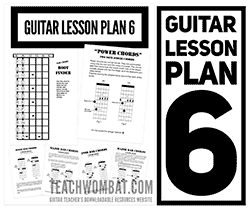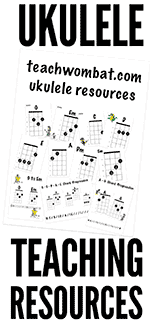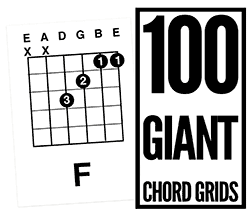Music theory as it relates to the guitar fretboard looking at how scales and chord progressions work

Music theory is simple just so long as the elements of it are taught in the right order The download contains the resources to allow you to teach music theory to guitar players simply and effectively

Guitar Music Theory Explained
Elements of Music Theory for Guitar needs to be studied in the right order
Below is a five step plan designed to give guitar players a sound,usable working knowledge of music theory
Guitar Music Theory Explained
1: Learn To Name Notes Correctly
2: Understand Whole-Step and Half-Step Intervals
3: Use Whole and Half Step Intervals to Construct Scales
4: Use Scales to Construct Chords
5: Use Scales and Chords to Understand Keys
Following the plan laid out in the easy to understand and free to download document shown below (left) provides guitar teachers with a method that makes music theory a tool that students can use to solve problems rather than being something thats (lets face it) not as much fun as just playing the guitar
Complete beginners to the should not learn music theory right away!
Music Theory should ideally be introduced when students are leaving the beginner stage and are entering into the intermediate phase of guitar playing When they can comfortably move between The Eight Chords That Any Beginner Should Learn First in time to music
The contents of a well rounded and useful study of music theory for the late stage beginner/early stage intermediate player should solve problems that they have (like which fret of which string should I base this power chord on?) rather than ask them questions for the sake of it
1: Learning To Name Notes Correctly

1: Naming Notes On the Fretboard Correctly
We need to have our students understand that some notes can have only one name (A B C D E F and G -the white notes on a piano keyboard) whilst others (the ones between A-B, C-D, D-E, F-G and G-A -the black notes on a keyboard) can have one of two names (a letter name followed by either a sharp or a flat sign) depending on the circumstance
While the above looks complicated written down we have graphic teaching aids designed to make sure that your students get to grips with the principles behind assigning the right name (or choice of names) to any note
2: Understand Whole Step and Half Step Intervals

Re-inforcing knowledge with worksheets
Worksheets are a great way to help and ensure that your student "gets" the logic underpinning music theory as it applies to guitar
Below you can see the "explainer" document and the three worksheets (with answer sheets) that are in the download that look at naming notes and then developing familiarity with notes a whole-step and a half step away from the note originally identified

2: Understanding Whole and Half-Step Intervals
Whole-step and half-step intervals are the gaps between notes
A whole-step is two frets and a half-step is one fret
Below you can see a detail that is taken from one of our three guitar teaching aids/worksheets (shown above) designed to help you to ensure that your student/s come to understand this vitally important element of music theory
Below you can see a detail of a section of one of the completed worksheets The arrows show whole and half step intervals and how they can be used to define the name (or potential names) of notes from a given starting point The worksheets also come with answer sheets that can be used if required

When Should A Guitar Teacher Introduce Music Theory to a Guitar Student?
The simple answer is when a knowledge of music theory will become a tool that the learner can use rather than a hurdle that they are required to overcome
You do not require any knowledge of music theory in order to learn, form and move between the The Eight Best Beginners Guitar Chords but you will find it useful for Teaching Power and Bar Chords on the neck of the guitar (which is the best next stage of development for a novice guitar player)
3: Using Whole-Step and Half-Step intervals in sequence to Construct Any Major Scale?
There is a sequence of whole step (W) and half-step (H) that allows the construction of a Major Scale from any starting note (A starting note of C will give you the notes of the C major Scale while a starting note of A will produce the notes of the A major Scale and so on) A whole-step is a "gap" of two frets between the notes and a half step gives a gap of one fret between them
The sequence (for any and all Major Scales) is W-W-H-W-W-W-H
All of the areas that should be studied during early guitar music theory lessons are addressed on the one page music theory scheme of work you can see at the top of this page and which you can download by clicking the button just below it

Major Scale Worksheets
Below are two of the worksheets in our download that help students to develop a "joined up" understanding of the principles involved in the construction of Major Scales
The worksheets (like the "explainer" PDfs featured above) do not use musical notation but instead rely on letter names. This is because of the simple reality that the vast majority of guitar players do not read music and the fact that you do not need to read music in order to understand how scales and chords work

Using The Worksheets
The worksheets feature graphic aids (keyboard and the note naming "oblong" discussed above) alongside a set of circles which run left to right. The larger circles have smaller, rounded shapes connecting them into which you will see that the letters "W" or "H" have been entered
As guitar teachers we need to stress to our students that even though the names of the notes changes with every scale the sequence of whole step and half step intervals (W-W-H-W-W-W-H) remains constant for all Major Scales

"W" = Whole-step interval (2 frets)
"H" = Half-step interval (1 fret)

Buy absolutely everything that you see on this website for only $25.00
All of the handouts, worksheets,lesson plans and backing tracks in an easy to use download
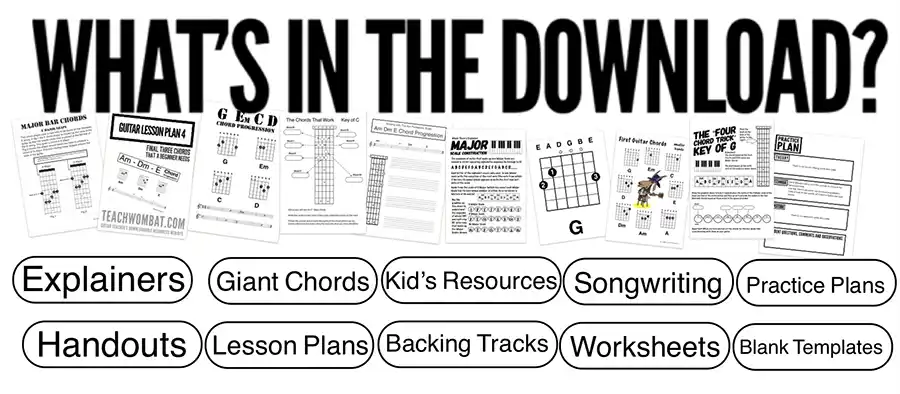
See A Complete List Of
Whats In The Download?
4: Use Scales To Construct Chords
Before we examine some more useful guitar music theory in detail here's a video that I put up on Youtube a while ago looking at how a guitar tutor may choose to teach one of the most important elements of music theory (how chords fit into keys) out there
When your students are familiar with this they will know how to come up with their own chord sequences that work every time without stumbling around the neck of the guitar till they find something that they don't mind hearing but which they don't understand
They will also be in a position to analyse the chord sequences of songs that they know and love in order to understand that this is the way that "professional" songwriters and musicians think
This Video Even Makes Sense With The Sound Muted!
Guitar Music Theory: From Scales To Chords to Keys
Moving our students on from understanding Major Scales to developing a knowledge of the chords that can be made up from them
One of the main attributes of guitar players who understand how major scales work is that they are in a position to then develop a joined-up knowledge of how each of the notes of a Major scale can then be used as the root note of a series of Major, minor and diminished chords that fall in a pre-determined sequence. Its the same for all keys so if they can understand the chords in the key of C then they can identify (and understand) the chords in any key
This is very similar to the way in which if they understand how sequence of whole-step (W) and half-step (H) intervals the scale of C Major is constructed then they are in a position to work out the names for the notes to be found in any Major Scale
Below you can see one of our handouts that guitar teachers use to help explain this (commonly called) "diatonic" system of harmony

5: Use Scales and Chords to understand Keys
When they can correctly identify the names of the notes in a "parent" Major scale then they can simply assign the appropriate chord quality (Major, minor or diminished) to each note of that scale
The order in which the chord qualities appear (major, minor or diminished) is always the same no matter which Major Scale you use!
Chord One = (always) Major
Chord Two = (always) minor
Chord Three = (always) minor
Chord Four = (always) Major
Chord Five = (always) Major
Chord Six = (always) minor
Chord Seven = (always) diminished
The handout shown above uses the notes of the C Major Scale (C,D,E,F,G,A and B)
The chords built on the first fourth and fifth notes (C F and G in the key of C Major) are always Major whist those built on the second, third and sixth notes (D, E and A) are minor chords (giving the chords of Dm, Em and Am). The chord built on the seventh note of the scale (B) is always a diminished chord (B diminished)
Using Guitar Music Theory Worksheets
The graphic below shows two of our worksheets that help allow students to find out that once they can work out (and remember) the diatonic system of chords in any one key they can use the same principles to transfer it to any other key

An understanding of the diatonic system allows our students to do two things...
The first is to give them an insight and understanding of the chords that they are likely to encounter when they are working out cover versions
The second (and in my view more important) benefit of understanding how chords within keys work is that they will be in a much better position when it comes to writing chord progressions for their own original music This fact alone is often enough to spur them on when it comes to developing a positive attitude to the development of a healthy theoretical approach to the instrument
Below you can see a detail from a completed worksheet that deals with all of the three note chords (triads) that can be made up by using the notes of the ("parent") A Major Scale
We should help our students to realise that the notes of any major scale follows the alphabetic sequence (A-B-C-D-E-F-G-A-B-C-D etc) regardless of whether there are sharps or flats involved and that the chord qualities (Major,minor or diminished) assigned to each degree of the scale remain constant regardless of which note the Major Scale starts from

Using Music Theory Worksheets to Teach Guitar
"The relationship between music theory and guitarists has always been a tricky one"
Guitar players often have a "love hate" relationship with music theory and if you survey a hundred different guitarists (ranging from jazz purists who need to understand the role and function of every note that they play through to Punk players who eschew anything that manifests itself as "rules") you will get a hundred different answers as to the role and function of music theory with relation to playing the guitar
The reason for this diversity of attitude and opinion (you are unlikely to find the same range of feelings among trumpet players) is tied up with the role of the guitar in recent popular culture and the fact that (unlike many other musical instruments) it is perfectly possible to get a great noise out of a guitar without having a clue what you are actually doing

This page makes the case for the study of music theory to be undertaken at the right time in a guitar player's career and also for the type of music theory to be studied We and our students want to know the information that is likely to be of use to us as guitar players in the type of situations in which we are likely to find ourselves rather than to concern ourselves at this stage with a broader musical (school music lesson type?) education in which the subject is generally covered in a way that is by necessity not slanted towards understanding music theory with reference to a particular instrument
I will also make the case that (unlike in the traditional study of music theory) we should (after becoming familiar with a single major scale) progress our students to the theory of how chords work as quickly as possible (after all, moving between chords is what our students have been mainly concerning themselves with up to this point in their progress)
By following this course we will help our students to understand what they already do before moving on to introduce new theoretical concepts
Why should our students pay attention to music theory when they can just go on youtube and find out where somebody famous once put their fingers on the neck of a guitar?
Music theory is not an end in itself The knowledge and application of it need to be appropriate to the stage that a guitar player is at in terms of his or her development In the early stages of becoming a guitar player (typically the period when a player is developing the ability to move between the easier open chords in time to music) a knowledge of music theory does not really have much of a role at all In terms of educational theory this stage is concerned totally with developing a facility within what is known as the "Phsychomotor Domain" which involves the aquisition of physical skills Put bluntly at this stage it does not confer any real benefit if the student understands the theory behind what they are doing It is more important just to do it
The problems with this approach to learning guitar comes after the initial stages Students, (self taught or otherwise) can become convinced that in order to make more progress on the guitar they need merely to keep on doing what they are already doing (learning chord sequences and songs "parrot fashion") and that by following this path they will continue to make reasonably rapid progress This is not the case What will happen is that although they will undoubtedly increase their repertoire they will become stuck in a rut
There are an awful lot of this type of guitar player about (perhaps they are the most common sort of guitarists) Somebody who enthusiastically learned the basics and practiced where to put their hands and to function (often very well) within a couple of scales but then the rate of progress slows down until they are just (competently) going over old ground and although they are enjoying themselves (and thats great) they are not really getting any better as musicians (and thats not)
Any Music Theory studied during guitar lessons needs to be useful to guitarists NOW!
The key to progress at this stage is to encourage them to take a step back in order to understand what they are already playing by rote and to help them to realise that by applying a little thought they will be able to understand how music (not just guitar) works It all starts with The Major Scale

Understanding Major Scales is the most important element of music theory for guitarists
Understanding Major Scales is absolutely crucial for guitarists for two reasons The first is that the construction of all other scales is defined by their relationship to the notes of a major scale and the second is that the chords that can be constructed from the notes of any major scale provide the harmonic basis of the majority of music that we hear
Developing an understanding of major scales and how they work is the most important thing that a guitar student can do with regard to understanding music theory but the problem is that guitar players in the beginning/intermediate stages of playing often dont tend to have too much use for the major scale. They seem (quite understandably) to have a lot more time for the pentatonic minor scale that will allow them to noodle away playing stuff that sounds like (and is) Rock and Blues music
Our job as guitar teachers is not to try to turn them off the pentatonic minor scale but to show them that the pentatonic minor is contained within any Major Scale (starting from the sixth note and selecting five of the eight notes in a pre-ordained sequence)
Understanding a single Major Scale and the chords that can be built from each of the notes within it are a great place to start using music theory in guitar lessons
If your intermediate guitar students can construct all of the chords that can be built from the notes of a single major scale they will have begun to develop an understanding of how the vast majority of songs are written

Click the link below to download a PDF containing all of the material that you can see in the image above
There are a whole load of resources and teacher's notes/explanations in the PDF that are designed to provide insight into the way that effective guitar teaching works
The downloaded materials will demonstrate that........
If your students can correctly identify the notes of a Major Scale then they can then build a (major, minor or diminished) chord on each note of the scale
The chord quality (Major, minor or diminished) of the chord built on each degree of the scale is the same in all keys (the chord built on the first, fourth and fifth notes will always be Major chords while those with a root note on the second, third and sixth notes will always be minor)
By identifying the notes of the relevant major scale and then hanging the correct chord quality (major, minor or diminished) on each note you can easily work out "The Chords That Work" in any key
Click to download student handouts/worksheets and guide to teaching music theory which demonstrates the chords that work in the key of A and a guitar teachers explanation of why the chords work
Working on the material outlined above is an ideal way to introduce music theory to guitar students who can play but don't really know what they are doing (or indeed why they are doing it?)
Any Music Theory studied during guitar lessons needs to be useful to guitarists NOW!
Our job as guitar teachers is not to try to turn them off the pentatonic minor scale but to show them that the pentatonic minor is contained within any Major Scale (starting from the sixth note and selecting five of the eight notes in a pre-ordained sequence)
When is a guitar student ready to start getting to grips with music theory?
The above statement is quite involved and if you ask a student who is ready to start a meaningful study of music theory (i.e. one who can move around the eight beginners chords in time to music, can maybe handle the F chord and is starting to get to grips with power chords and basic bars) if they would like to study how pentatonic minor scales are contained within Major Scales they will most likely nod politely while wondering what the dickens you are on about. They will maybe even start to get that familiar feeling from their least favourite lesson at school where someone stood at the front of the class and droned on about something that everyone else seemed to understand but which they found completely incomprehensible
This is not a feeling that you (or I) want to instill in a customer upon whose money we depend We want them to feel happy and motivated (our living depends on it) and rather than present them with complicated notions of a five note scale being contained within a seven note scale I tend to introduce my students to the concept of music theory in a different way I ask them a question to which there is only one (usually very enthusiastic) answer
How to teach songwriting skills to guitar students
We are guitar teachers. We earn money teaching the guitar. Thats what we are all about. That is what people pay us for and expect us to do. Its all very simple but if you look a little deeper into the motivation of our students (and ourselves) perhaps guitar teaching is only one of the things that we can get paid for.
Very few people take up the guitar determined that they will never write a song but the reality is that most people who play the guitar do not write songs (or not ones they are prepared to show to anyone else anyway). Songwriting can seem like a bit of a "black art" and the impression can form that the only people who can do it are a select group of artistic and inspired individuals who have the "keys to the kingdom"
The (fortunate) reality is that the technical elements of writing songs (song structure, melody and harmony) are not too difficult for any guitar student who has made it to the intermediate stage (where they can form and move between the eight chords that any beginner should learn first
The remainder of this page is concerned with helping us to help our students to understand enough about how the chordal (harmonic) element of songwriting works that they will not be be intimidated by the whole idea. We start with an introduction to the "Four Chord Trick" in the ("guitar friendly") key of G

The Four Chord Trick
The "Four Chord Trick" in the "Guitar Friendly" key of G
The reason that we use the key of G to introduce beginners to songwriting is that by the time a student is capable of moving between the eight chords that they should learn first in time to a backing track then they are at the ideal stage to start to use those chords creatively to come up with their own music. There is no minimum requirement in terms of skill and technique than this
I know (and I'm sure you do too) a whole load of really good guitar players who can fly all over the neck of the instrument, spend just about all of their time and money on guitars, have "excellent" musical taste which seems to consist of music made by a bunch of men (and it is normally men) who can play even faster than they can but who nobody else seems to have heard of. They have put the hours in yet they seem reluctant to engage with something as (seemingly) simple as writing a song using just a few well chosen chords
I am not trying to start a fight here and would stress that some of my favourite music is made by men who can play (much much) faster than me but the reality is that most "civilians" (non musicians) are much more impressed by a good song than they are by somebody who can solder the strings to the frets with the heat generated by their hypersonic digits. Record sales figures and concert attendances would appear to lend credence to my statement
Another thing to bear in mind as a teacher is that no matter what the ambition of your beginner student is he or she is not going to get the call from Dream Theatre without many years (decades even?) of dedicated technical and theoretical endeavour during which time they will most probably get sidetracked by work, education, marriage, divorce, kids, jobs, facebook, beer and just about anything else that can eat your life before you have got to live it
Musical "excellence" is a worthy goal (in fact we have a load of guitar teaching materials aimed at intermediate or advanced players) and I would hate you to think that I'm suggesting that you dont encourage your students to work on the technical and theoretical concepts that will lift them above the herd (thats one of the things that they pay you for) but if guitar teachers pass up on the chance to instill in our students the belief that they can make a worthwhile contribution to original music even at a relatively early stage of what (if it didn't make a little bit of sick come into my mouth) we could call their "guitar playing journey" then we might not be doing our job as well as we think we are

The "Four Chord Trick" see the student worksheet that you can download in the graphic above which is a great introduction to music theory on the guitar because from the word go the study of theory becomes useful to the student. All too often the study of music theory is tilted too far towards "theory" and not far enough toward "music"
The four chord trick can be divided into three simple steps.........
Step 1: Find the notes of the (G) Major Scale
Help your student to identify and record the notes of the G Major Scale and draw their attention to the concept of "whole-step" (two fret) and "half-step" (one fret) intervals. This is important as all major scales follow the same (W-W-H-W-W-W-H) sequence of intervals so by developing the ability to work out the chords of the "four chord trick" from the notes of the G Major scale they will be doing the preparation for working out the chords in other keys on the guitar

Step 2: Hang Major Chords on the first (root), fourth and fifth notes of the scale

Step 3: Hang a minor chord on the sixth note of the scale

Its as simple as that

The above worksheets that come as part of the teachwombat materials all deal with what are generally thought of as being the most "guitar friendly" keys. They are regarded as being that way because to a greater or lesser extent they heavily feature chords that can be played using open strings. Having said that the "four chord trick" in any other key than G will require a player to use at least one bar chord so they do not work as well for a beginner

Generally speaking people who write music on guitar tend to gravitate towards the "sharp keys" because they exploit some of the natural features of the instrument but of course the other keys (the flat keys) are every bit as valid and useful in other circumstances (such as playing with brass instruments or individual singers who operate better in particular keys where capos often come into play)

They are not "Jazz Chords" they are just chords often found in Jazz Music!
People (including me) will often lazily refer to "jazz chords" but the reality is that just like the blues scale (which is heavily featured in most kinds of popular music that came after it first turned up in the Southern states of America in the late nineteenth century) Jazz harmony is everywhere
If a guitar teacher understands how five common four note chords are put (and work) together then they they can teach the music theory behind just about all popular music forms
Buy absolutely everything that you can see on this website for a single payment of $25.00
The Download Contains....
Beginners Guitar Teaching Materials
Childrens Guitar Teaching Resources
Printable Guitar Teaching Aids
35 Backing Tracks and over 80 Chord Charts etc to go with them
Blank Guitar Necks, Tab and Chord Sheets
Guitar Music Theory Resources
Teaching Songwriting to Guitar Players
100 Letter Sized Giant Printable Chord Grids
An introduction to Jazz Guitar Teaching Materials
HOW TO DOWNLOAD
Absolutely all of the resources that you see on this website for $25.00
Buy your teachwombat.com resources in complete safety via any major credit card (through paypal) or directly through your paypal account if you have one. If you choose to use a credit card, rest assured that we never see your credit card details as paypal do all of that for us.
When Paypal receive your payment you will be immediately invited to click a
"RETURN TO SELLER"button.
You will be taken to a page from where you will have 72 hours to download the products that you have paid for NOW!
In the (rare) event that something should go wrong with the order/download process just email me at robh@teachwombat.com
Cheers! Rob!
The Deluxe Package:
Download all of our products for just $25.00
Guitar and bass teacher's toolkit (with business cards and diary/accounts pages) backing tracks and handouts- and giant guitar grids
the package consists of...........
The Backing Tracks and Handouts Package
35 Backing Tracks and over 60 Handouts. An invaluable aid designed to help you to teach both rhythm and lead guitar." If they can't play in time then they can't play?"
The Guitar Teacher's Toolkit
100 printable sheets covering Open Chords-Bar Chords-Scales- Modes- Blank Fretboard and Chord Grids Teaching Diary and Business Card Designs
The Bass Teacher's Toolkit
Over 60 Handouts covering Scales, Chords, Fingering Exercises etc
Plus 100 Giant (letter sized) Chord Grids
laminate them in order to help you to teach group guitar lessons, distribute them to your students or just stick on your teaching studio wall? The "Coolest Wallpaper on the planet?"
Over 450 Sheets to Download and use TODAY!
Everything you need to start or improve a guitar teaching business! It's all there!
$25.00
Click The PayPal logo above to purchase and download absolutely everything that you can see and hear of this website NOW


